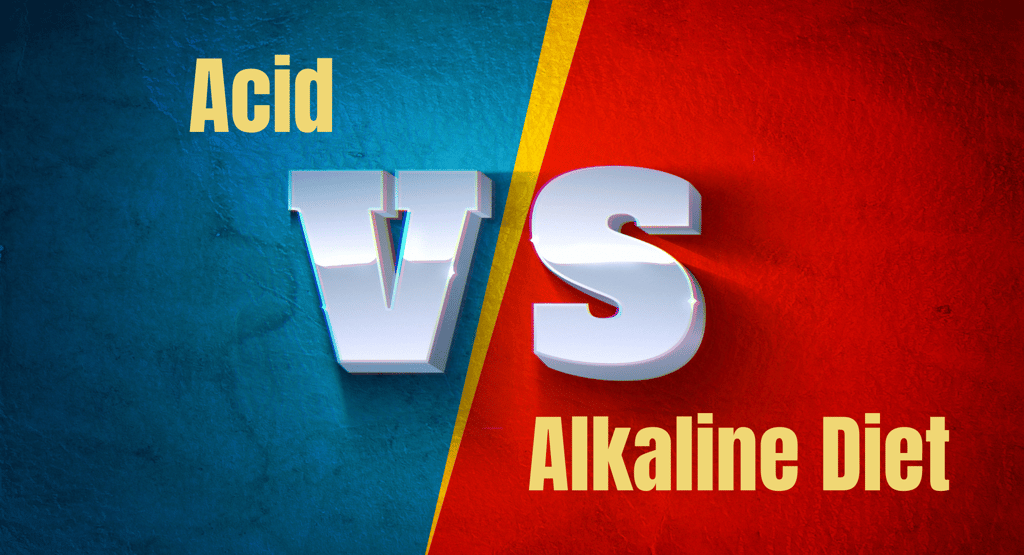Acid vs. Alkaline Diet?
In this article, I will answer the question of “acid vs. alkaline diet; which is the good?” Well, ok, it’s quite obvious from where I’m sitting; I mean who wants to say their body is mostly acid? But, what are the benefits of having an alkaline diet, over an acid diet?


Understanding pH Levels and Their Importance
The term "pH" stands for "potential of hydrogen," and it is a scale used to specify the acidity or alkalinity of a solution. The pH scale ranges from 0 to 14, with 7 being neutral. Values below 7 indicate acidity, while values above 7 signify alkalinity. The human body meticulously regulates its internal pH across various systems to maintain optimal function. The ideal pH for human blood is slightly alkaline, around 7.35 to 7.45.
Maintaining a balanced pH is critical for overall health as it influences several bodily functions:
Enzymatic Activity: Enzymes function most efficiently in environments that match their specific pH preference. Deviations from this optimal pH can hinder enzyme performance, affecting metabolic processes and overall health.
Immune System: The immune system depends on a balanced pH to function correctly. An overly acidic or alkaline environment can impair the body's ability to fend off infections and respond to inflammation.
Repair Mechanisms: The body's repair mechanisms, such as cell regeneration and tissue repair, are optimized when pH levels are balanced. An imbalance can slow down these processes, leading to prolonged recovery times and increased susceptibility to illness.
The body employs various mechanisms to maintain pH balance:
Respiration: The lungs regulate pH by controlling the levels of carbon dioxide, which can influence blood acidity.
Urination: The kidneys excrete excess acids or bases to maintain this delicate balance.
Buffering Capacity of Blood: Blood buffers neutralize excess acids or bases to maintain stable pH levels.
Understanding pH levels and their importance is vital for comprehending the broader implications of diet on health. Both acidic and alkaline foods can influence the body's pH, making it essential to consume a balanced diet that supports the body's natural regulatory mechanisms.
What is an Acidic Diet?
An acidic diet primarily consists of foods that contribute to the body's acidity levels:
Animal Proteins: Red meats, poultry, and fish produce acidic byproducts when metabolized.
Dairy Products: Cheese, milk, and yogurt are rich in animal protein, contributing to higher acid levels.
Processed Foods: Often laden with preservatives and artificial additives, these exacerbate the acid load.
Sugary Beverages: Sodas and energy drinks, high in sugar content and artificial ingredients, significantly contribute to acidity.
Indian Context
Spicy and Fried Foods: Common in Indian cuisine, these can also contribute to higher acidity.
Pickles and Chutneys: Often acidic due to the use of vinegar and salt.
Potential health impacts of an acidic diet include:
Increased Risk of Inflammation: Chronic inflammation is a precursor to various health conditions such as arthritis and cardiovascular diseases.
Weakened Immune System: A consistently high acid intake may impair the body's ability to fend off infections and illnesses.
Long-Term Health Issues:
Osteoporosis: The body may leach calcium from bones to neutralize the acid, leading to brittle bones.
Kidney Stones: The kidneys filter out excess acid, which can result in the formation of painful stones.
Understanding the implications of an acidic diet is crucial for making informed dietary choices. While occasional consumption of acidic foods is not inherently harmful, a diet heavily skewed towards acid-producing foods can pose significant health risks over time. Balancing the intake of acidic and alkaline foods may help mitigate these potential drawbacks and contribute to overall well-being.
What is an Alkaline Diet?
An alkaline diet primarily focuses on the consumption of foods that promote alkalinity in the body. This dietary approach emphasizes:
Core Components: Fresh fruits, vegetables, nuts, and seeds.
Recommended Foods: Spinach, kale, broccoli, avocados, almonds, chia seeds.
Indian Context:
Fruits: Bananas, pomegranates, mangoes, and melons.
Vegetables: Spinach (palak), bottle gourd (lauki), bitter gourd (karela), and pumpkin (kaddu).
Nuts and Seeds: Almonds, flaxseeds, and chia seeds.
Health benefits of an alkaline diet include:
Improved Energy Levels: An alkaline environment enhances cellular function and energy production.
Better Digestion: The high fiber content in fruits and vegetables aids in smoother digestive processes and prevents issues like bloating and constipation.
Enhanced Immune Function: Rich in antioxidants, vitamins, and minerals, an alkaline diet supports a robust immune system and reduces inflammation.
Reduced Risk of Chronic Diseases: Lower intake of acidic foods decreases the likelihood of conditions like heart disease, diabetes, and certain cancers.
The theory behind the alkaline diet is that foods consumed can influence the body's acid-base balance. Advocates believe that eating more alkaline foods helps neutralize excess acidity, maintaining optimal pH balance and enhancing overall health.
Comparing the Health Benefits: Acidic vs. Alkaline Diet
Both acidic and alkaline diets influence various aspects of health:
Alkaline Diet:
Emphasizes fruits, vegetables, nuts, and legumes.
May improve bone health by reducing calcium loss, potentially lowering the risk of osteoporosis.
High intake of plant-based foods can help maintain muscle mass.
Acidic Diet:
Often includes higher consumption of animal proteins, grains, and processed foods.
Potentially increases the risk of chronic diseases due to higher intake of saturated fats and cholesterol.
Balanced intake, combined with adequate fruits and vegetables, can still provide essential nutrients.
While the body's pH levels are tightly regulated, the emphasis on nutrient-dense, plant-based foods in an alkaline diet aligns well with general dietary guidelines for promoting health. Conversely, the risks associated with an acidic diet can often be mitigated by ensuring a diverse and balanced nutritional intake.
Practical Tips for Adopting an Alkaline Diet
Transitioning to an alkaline diet can be rewarding. Here are some practical tips:
Meal Planning:
Incorporate more fresh fruits and vegetables into your meals.
Aim to fill at least half of your plate with alkaline-rich foods.
Foods to Incorporate:
Focus on adding alkaline-forming foods like almonds, avocados, and tofu.
Use fresh herbs such as basil and parsley to enhance flavor.
Foods to Avoid:
Limit intake of acidic foods like red meat, dairy products, and processed foods.
Reduce consumption of sugary beverages and caffeinated drinks.
Indian Context:
Breakfast: Start your day with a bowl of fresh fruits like papaya or a smoothie with spinach and cucumber.
Lunch: Opt for a salad with mixed greens, cucumbers, and a lemon-tahini dressing, or a vegetable stir-fry with tofu.
Dinner: Prepare a hearty dal (lentil soup) with lots of vegetables or a quinoa pulao with assorted veggies.
Snacks: Raw almonds, vegetable sticks, or a small bowl of mixed fruit.
Recipe Ideas:
Breakfast: Avocado toast on whole-grain bread with cherry tomatoes and sea salt.
Lunch: Quinoa salad with mixed greens, cucumbers, bell peppers, and lemon-tahini dressing.
Dinner: Veggie stir-fry with tofu, broccoli, bell peppers, and ginger-garlic sauce.
Overcoming Challenges:
Keep healthy snacks like raw almonds or vegetable sticks handy to combat cravings.
Opt for vegetable-based dishes when dining out and ask for modifications when possible.
Stay hydrated with alkaline water.
By gradually incorporating these tips into your daily routine, transitioning to an alkaline diet can become a manageable and sustainable lifestyle change.
Conclusion: Finding the Right Balance
After examining both the acid and alkaline diets, it's clear that each has its own set of advantages. An alkaline diet emphasizes the consumption of fruits, vegetables, nuts, and legumes, which are undeniably beneficial for overall health. These foods are rich in essential nutrients and antioxidants that can improve well-being, support immune function, and potentially reduce the risk of chronic diseases.
On the other hand, certain acidic foods such as lean meats, dairy, and grains also play a crucial role in providing a balanced intake of essential amino acids, calcium, and other nutrients that are vital for bodily functions. Therefore, the key to optimal health does not lie strictly in adhering to one diet over the other but in finding a harmonious balance that suits individual needs.
Each person's dietary requirements can vary based on multiple factors, including age, health status, activity level, and personal health goals. It is important to listen to your body and observe how it responds to different foods. Consulting with healthcare professionals or a registered dietitian can provide personalized insights and help in crafting a balanced diet plan that includes both acidic and alkaline foods in appropriate proportions.
Ultimately, the focus should be on maintaining a varied diet that includes a wide range of nutrient-rich foods, ensuring that your body receives all the vitamins, minerals, and other nutrients it needs to function optimally. By making informed dietary choices and striving for balance, you can support your overall health and well-being effectively.
Disclaimer: This fact sheet by the “NutrifyTheWorld” provides information that should not take the place of medical advice. We encourage you to talk to your health care providers (doctor, registered dietitian, pharmacist, etc.) about your interest in, questions about, or use of dietary supplements and what may be best for your overall health. Any mention in this publication of a specific product or service, or recommendation from an organization or professional society, does not represent an endorsement by OSD of that product, service, or expert advice.


